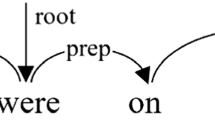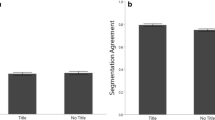Abstract
Several current models of human parsing maintain that initial structural decisions are influenced (or tuned) by the listener's or reader's prior contact with language. The precise workings of these models depend upon the “grain,” or level of detail, at which previous exposures to language are analyzed and used to influence parsing decisions. Some models are premised upon the use of fine-grained records (such as lexical cooccurrence statistics). Others use coarser measures. The present paper considers the viability of models based exclusively on the use of fine-grained lexical records. The results of several studies are reviewed and the evidence suggests that, if they are to account for the data, experience-based parsers must draw upon records or representations that capture statistical regularities beyond the lexical level. This poses problems for several parsing models in the literature.
Similar content being viewed by others
References
Adams, B. C., Clifton, C., Jr., & Mitchell, D. C. (1991).Lexical guidance in sentence parsing. Poster presented at the meeting of the Psychonomics Society, San Francisco.
Bates, E., & MacWhinney, B. (1987). Competition variation and language learning. In B. MacWhinney (Ed.),Mechanisms of language acquisition (pp. 157–193). Hillsdale, NJ: Earlbuam.
Bever, T. G. (1970). The cognitive basis for linguistic structures. In J. R. Hayes (Ed.),Cognition and the development of language (pp. 279–360). New York: Wiley.
Boland, J. E., & Tanenhaus, M. K. (1991). The role of lexical representation in sentence processing. In G. B. Simpson (Ed.),Understanding word and sentence (pp. 331–366). Amsterdam: Elsevier.
Boland, J. E., Tanenhaus, M. K., Carlson, G., & Garnsey, S. M. (1989). Lexical projection and the interaction of syntax and semantics in parsing.Journal of Psycholinguistic Research, 18, 563–576.
Boland, J. E., Tanenhaus, M. K., & Garnsey, S. M. (1990). Evidence for the immediate use of verb control information in sentence processing.Journal of Memory and Language, 29, 413–432.
Branigan, H., Pickering, M. J., Liversedge, S. P., Stewart, A. J. & Urbach, T. P. (1995). Syntactic priming: Investigating the mental representation of language.Journal of Psycholinguistic Research, 24 (this issue).
Brysbaert, M., & Mitchell, D. C. (in press). Modifier attachment in sentence parsing: Evidence from Dutch.Quarterly Journal of Experimental Psychology.
Carey, P. W., Mehler, J., & Bever, T. G. (1970). Judging the veracity of ambiguous sentences.Journal of Verbal Learning and Verbal Behavior, 9, 243–254.
Clifton, C. E., Jr., (1993). Thematic roles in sentence parsing.Canadian Journal of Experimental Psychology, 47, 222–246.
Corley, M. M. B., & Corley, S. (1995).Cross-linguistic and intra-linguistic evidence for the use of statistics in human sentence processing. Unpublished manuscript, University of Exeter.
Cuetos, F., & Mitchell, D. C. (1988). Cross-linguistic differences in parsing: Restrictions on the use of the late closure strategy in Spanish.Cognition, 30, 73–105.
Cuetos, F., Mitchell, D. C., & Corley, M. M. B. (in press). Parsing in different languages. In M. Carreiras, J. Garcia-Albea, & N. Sabastian-Galles (Eds.),Language processing in Spanish. Hillsdale, NJ: Erlbaum.
Ford, M., Bresnan, J. W., & Kaplan, R. M. (1982). A competence based theory of syntactic closure. In J. W. Bresman (Ed.),The mental representation of grammatical relations (pp. 727–796). Cambridge, MA: MIT Press.
Frazier, L. (1987). Sentence processing: A tutorial review. In M. Coltheart (Ed.),Attention and performance XII (pp. 601–681). Hillsdale, N.J.: Erlbaum.
Frazier, L. (1989). Against lexical generation of syntax. In W. Marslen-Wilson (Ed.),Lexical representation and process (pp. 505–528). Cambridge, MA: MIT Press.
Frazier, L., Taft, L., Roeper, T., & Clifton, C. (1984). Parallel structure: A source of facilitation in sentence comprehension.Memory & Cognition, 12, 421–430.
Gilboy, E., Sopena, J. M., Clifton, C. Jr., & Frazier, L. (1995). Argument structure and association preferences in Spanish and English complex NPs.Cognition.54, 131–167.
Hemforth, B., Konieczny, L., & Scheepers, C. (1994). Principle-based and probabilistic approaches to human parsing: How universal is the human language processor? In H. Trost (Ed.),Tagunsband KONVENS '94 (pp. 161–170). Berlin: Springer.
Juliano, C., & Tanenhaus, M. K. (1994). A constraint-based lexicalist account of the subject-object attachment preference.Journal of Psycholinguistic Research, 23, 459–471.
Konieczny, L., & Strube, G. (1995). SOUL: A cognitive parser. InProceedings of the 17th Annual Conference of the Cognitive Science Society. (pp. 631–636). Mahwah, NJ: Erlbaum.
MacDonald, M. C., Pearlmutter, N. J., & Seidenberg, M. S. (1994). The lexical nature of syntactic ambiguity resolution.Psychological Review, 101, 676–703.
Mehler, J., & Carey, P. W. (1967). The role of serface and base structure in the perception of sentences.Journal of Verbal Learning and Verbal Memory, 6, 335–338.
Mitchell, D. C. (1987). Lexical guidance in human parsing: Locus and processing characteristics. In M. Coltheart (Ed.),Attention and performance XII (pp. 601–681). Hillsdale, NJ: Erlbaum.
Mitchell, D. C. (1989). Verb guidance and lexical effects in ambiguity resolution.Language and Cognitive Processes, 4, 123–154.
Mitchell, D. C. (1994). Sentence parsing. In M. Gernsbacher (Ed.),Handbook of psycholinguistics (pp. 375–409). New York: Academic Press.
Mitchell, D. C., & Cuetos, F. (1991a). The origins of parsing strategies. In C. Smith (Ed.),Current issues in natural language processing. Austin: Center for Cognitive Science, University of Texas.
Mitchell, D. C., & Cuetos, F. (1991b). Restrictions on late closure: The computational underpinnings of parsing strategies in Spanish and English. Unpublished paper, University of Exeter.
Mitchell, D. C., Cuetos, F., & Corley, M. M. B. (1992, March).Statistical versus linguistic determinants of parsing bias: Cross-linguistic evidence. Paper presented at the 5th Annual CUNY Conference on Sentence Processing, New York.
Mitchell, D. C., Cuetos, F., & Zagar, D. (1990). Reading in different languages: Is there a universal mechanism for parsing sentences? In D. Balota, G. B. Flores d'Arcais, & K. Rayner (Eds.),Comprehension processes in reading (pp. 285–302). Hillsdale, NJ: Erlbaum.
Pearlmutter, N. J., Daugherty, K. G., MacDonald, M. C., & Seidenberg, M. S. (1994). Modeling the use of frequency and contextual biases in sentence processing. InProceedings of the 16th Annual Conference of the Cognitive Science Society (pp. 699–704). Hillsdale, NJ: Erlbaum.
Spivey-Knowlton, M. (1994). Quantitative predictions from a constraint-based theory of syntactic ambiguity resolution. In M. Mozer, P. Smolensky, D. Touretzky, J. Elman, & A. Weigland (Eds.),Proceedings of the 1993 Connectionist Models Summer School (pp. 130–137). Hillsdale, NJ: Erlbaum.
Spivey-Knowlton, M., & Sedivy, J. C. (1995). Resolving attachment ambiguities with multiple constraints.Cognition, 55, 227–267.
Tabossi, P., Spivey-Knowlton, M., McRae, K., & Tanenhaus, M. K. (1994). Semantic effects on syntactic ambiguity resolution: Evidence for a constraint-based resolution process. In C. Umilta and M. Moscovitch (Eds.),Attention and performance XV (pp. 589–615). Hillsdale, NJ: Erlbaum.
Tanenhaus, M. K., Boland, J. E., Mauner, G., & Carlson, G. N. (1993). More on combinatory lexical information: Thematic structure in parsing and interpretation. In G. T. M. Altmann and R. C. Shillcock (Eds.),Cognitive models of speech processing: The second Sperlonga meeting (pp. 297–319). Hillsdale, NJ: Erlbaum.
Tanenhaus, M. K., Carlson, G., & Trueswell, J. C. (1989). The role of thematic structures in interpretation and parsing.Language and Cognitive Processes, 4, 211–234.
Tanenhaus, M. K., Garnsey, S. M., & Boland, J. (1990). Combinatory lexical information and language comprehension. In G. T. M. Altmann (Ed.),Cognitive models of speech processing (pp. 383–408) Cambridge, MA: MIT Press.
Tanenhaus, M. K., & Juliano, C. (1992, March).What to do about ‘that’: Use of cooccurrence information in parsing. Paper presented at the 5th Annual CUNY Conference on Sentence Processing, New York.
Traxler, M. J., & Pickering, M. J. (1995, March).Evidence against statistical parsing. Poster presented at the 8th Annual CUNY Conference on Sentence Processing, Tucson.
Trueswell, J. C., Tanenhaus, M. K., & Garnsey, S. M. (1994). Semantic influences on parsing: Use of thematic role information in syntactic disambiguation.Journal of Memory and Language, 33, 285–318.
Trueswell, J. C., Tanenhaus, M. K., & Kello, C. (1993). Verb-specific constraints in sentence processing: Separating effects of lexical preference from garden-paths.Journal of Experimental Psychology: Learning, Memory and Cognition, 19, 528–553.
Zagar, D., & Pynte, J. (1992, September).The role of semantic information and of attention in processing syntactic ambiguity: Eye-movement study. Paper presented at the 5th conference of the European Society for Cognitive Psychology, Paris.
Zagar, D., Pynte, J., & Rativeau, S. (1995).Effects of context and strategy in human sentence parsing: The depth-tuning hypothesis. Manuscript submitted for publication.
Author information
Authors and Affiliations
Additional information
Aspects of this work were supported by ESRC grant No. R0023 4062 to Don Mitchell, by a Spanish Government grant DGICVT No. PB-92-0656-C04-02 to Fernando Cuetos, and by the Belgian National Fonds voor Wetenschappelijk Onderzoek, of which Marc Brysbaert is a Research Associate. We are grateful to Chuck Clifton, Barbara Hemforth, Martin Pickering, Matt Traxler, and an anonymous reviewer-all of whom made helpful comments on an earlier draft of the paper.
Rights and permissions
About this article
Cite this article
Mitchell, D.C., Cuetos, F., Corley, M.M.B. et al. Exposure-based models of human parsing: Evidence for the use of coarse-grained (nonlexical) statistical records. J Psycholinguist Res 24, 469–488 (1995). https://doi.org/10.1007/BF02143162
Accepted:
Issue Date:
DOI: https://doi.org/10.1007/BF02143162




